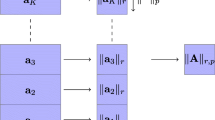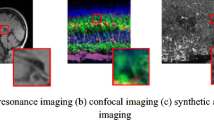Abstract
The dictionary-based method is an important approach to image denoising. In the existing methods, the dictionary is either pre-defined or learned adaptively from the data under certain constraints such as sparsity or orthogonality, which often leads to an approximation solution. In this paper, we propose a novel supervised dictionary learning model with smooth shrinkage for image denoising. By incorporating the dictionary learning into the denoising target, our model is trained in a task-driven fashion without the need of explicit constraints. We analyze the proposed model theoretically and show that it tends to learn sparse and orthogonal dictionaries, which is further verified empirically. Experimental results on four different noise levels demonstrate the effectiveness of our model both quantitatively and visually in comparison with the classical dictionary-based denoising methods.





Similar content being viewed by others
References
Agostinelli F, Hoffman M, Sadowski P, Baldi P (2014) Learning activation functions to improve deep neural networks. arXiv preprint arXiv:1412.6830
Aharon M, Elad M, Bruckstein A (2006) K-SVD: an algorithm for designing overcomplete dictionaries for sparse representation. IEEE Trans Signal Process 54(11):4311–4322
Alain G, Bengio Y (2014) What regularized auto-encoders learn from the data-generating distribution. J Mach Learn Res 15(1):3563–3593
Atto AM, Pastor D, Mercier G (2008) Smooth sigmoid wavelet shrinkage for non-parametric estimation. In: International conference on acoustics, speech, and signal processing, pp 3265–3268
Bengio Y, Lamblin P, Popovici D, Larochelle H (2007) Greedy layer-wise training of deep networks. Adv Neural Inf Process Syst 19:153
Cai D, He X, Han J, Huang TS (2011) Graph regularized nonnegative matrix factorization for data representation. IEEE Trans Pattern Anal Mach Intell 33(8):1548–1560
Cormen TH, Leiserson CE, Rivest RL, Stein C (2001) Introduction to algorithms, vol 6. MIT press, Cambridge
Dong W, Zhang L, Shi G, Li X (2013) Nonlocally centralized sparse representation for image restoration. IEEE Trans Image Process 22(4):1620–1630
Donoho DL, Johnstone JM (1994) Ideal spatial adaptation by wavelet shrinkage. Biometrika 81(3):425–455
Elad M (2010) Sparse and redundant representations: from theory to applications in signal and image processing. Springer, Berlin
Elad M, Aharon M (2006) Image denoising via sparse and redundant representations over learned dictionaries. IEEE Trans Image Process 15(12):3736–3745
He K, Zhang X, Ren S, Sun J (2015a) Delving deep into rectifiers: surpassing human-level performance on imagenet classification. In: Proceedings of the IEEE international conference on computer vision, pp 1026–1034
He YC, Lu HT, Huang L, Shi XH (2015b) Non-negative matrix factorization with pairwise constraints and graph laplacian. Neural Process Lett 42(1):167–185
Hinton GE, Salakhutdinov RR (2006) Reducing the dimensionality of data with neural networks. Science 313(5786):504–507
Hinton GE, Osindero S, Teh YW (2006) A fast learning algorithm for deep belief nets. Neural Comput 18(7):1527–1554
Hyvärinen A (1999) Sparse code shrinkage: denoising of nongaussian data by maximum likelihood estimation. Neural Comput 11(7):1739–1768
Hyvärinen A, Hoyer PO (2001) A two-layer sparse coding model learns simple and complex cell receptive fields and topography from natural images. Vis Res 41(18):2413–2423
Krishnan D, Fergus R (2009) Fast image deconvolution using hyper-Laplacian priors. In: Bengio Y, Schuurmans D, Lafferty JD, Williams CKI, Culotta A (eds) Advances in neural information processing systems. Curran Associates, Inc., pp 1033–1041
Le QV, Karpenko A, Ngiam J, Ng AY (2011) ICA with reconstruction cost for efficient overcomplete feature learning. In: Shawe-Taylor J, Zemel RS, Bartlett PL, Pereira F, Weinberger KQ (eds) Advances in neural information processing systems. Curran Associates, Inc., pp 1017–1025
LeCun YA, Bottou L, Orr GB, Müller KR (2012) Efficient backprop. In: Montavon G, Orr GB, Müller KR (eds) Neural networks: tricks of the trade: Second edition. Springer, Berlin, Heidelberg, pp 9–48. doi:10.1007/978-3-642-35289-8_3
Liu W, Zha ZJ, Wang Y, Lu K, Tao D (2016) \( p \)-Laplacian regularized sparse coding for human activity recognition. IEEE Trans Ind Electron 63(8):5120–5129
Mairal J, Ponce J, Sapiro G, Zisserman A, Bach FR (2009) Supervised dictionary learning. In: Koller D, Schuurmans D, Bengio Y, Bottou L (eds) Advances in neural information processing systems. Curran Associates, Inc., pp 1033–1040
Mairal J, Bach F, Ponce J (2012) Task-driven dictionary learning. IEEE Trans Pattern Anal Mach Intell 34(4):791–804
Martin D, Fowlkes C, Tal D, Malik J (2001) A database of human segmented natural images and its application to evaluating segmentation algorithms and measuring ecological statistics. In: International conference on computer vision, vol 2. pp 416–423
Ngiam J, Coates A, Lahiri A, Prochnow B, Le QV, Ng AY (2011) On optimization methods for deep learning. In: International Conference on Machine Learning, pp 265–272
Olshausen BA, Field DJ (1997) Sparse coding with an overcomplete basis set: a strategy employed by V1? Vis Res 37(23):3311–3325
Pati YC, Rezaiifar R, Krishnaprasad P (1993) Orthogonal matching pursuit: recursive function approximation with applications to wavelet decomposition. In: Twenty-seventh asilomar conference on signals, systems and computers, pp 40–44
Portilla J, Strela V, Wainwright MJ, Simoncelli EP (2003) Image denoising using scale mixtures of gaussians in the wavelet domain. IEEE Trans Image Process 12(11):1338–1351
Rubinstein R, Elad M (2014) Dictionary learning for analysis-synthesis thresholding. IEEE Trans Signal Process 62(22):5962–5972
Rubinstein R, Peleg T, Elad M (2013) Analysis K-SVD: a dictionary-learning algorithm for the analysis sparse model. IEEE Trans Signal Process 61(3):661–677
Shang L, Cao FW (2006) Adaptive denoising using a modified sparse coding shrinkage method. Neural Process Lett 24(2):153–162
Sprechmann P, Litman R, Yakar TB, Bronstein A, Sapiro G (2013) Efficient supervised sparse analysis and synthesis operators. In: Annual conference on neural information processing systems
Tomczak JM (2015) Learning informative features from restricted boltzmann machines. Neural Process Lett 44:1–16
Wang X, Wang C, Shang L, Sun ZL (2016) Dispersion constraint based non-negative sparse coding model. Neural Process Lett 43(2):603–609
Wang Z, Huang Y, Luo X, Wang L, Luo S (2011) Learning topographic representations of nature images with pairwise cumulant. Neural Process Lett 34(2):155–175
Wu F, Jing XY, Yue D (2016) Multi-view discriminant dictionary learning via learning view-specific and shared structured dictionaries for image classification. Neural Process Lett pp 1–18
Zeng X, Bian W, Liu W, Shen J, Tao D (2015) Dictionary pair learning on Grassmann manifolds for image denoising. IEEE Trans Image Process 24(11):4556–4569
Zhao H, Luo J, Huang Z, Nagumo T, Murayama J, Zhang L (2015) Statistically adaptive image denoising based on overcomplete topographic sparse coding. Neural Process Lett 41(3):357–369
Acknowledgements
The work was supported by the National Natural Science Foundation of China (Grant No. 91420302), the National Basic Research Program of China (Grant No. 2015CB856004) and the Key Basic Research Program of Shanghai (Grant No. 15JC1400103).
Author information
Authors and Affiliations
Corresponding author
Rights and permissions
About this article
Cite this article
Zhang, K., Zhang, L. Supervised Dictionary Learning with Smooth Shrinkage for Image Denoising. Neural Process Lett 47, 535–548 (2018). https://doi.org/10.1007/s11063-017-9665-8
Published:
Issue Date:
DOI: https://doi.org/10.1007/s11063-017-9665-8




